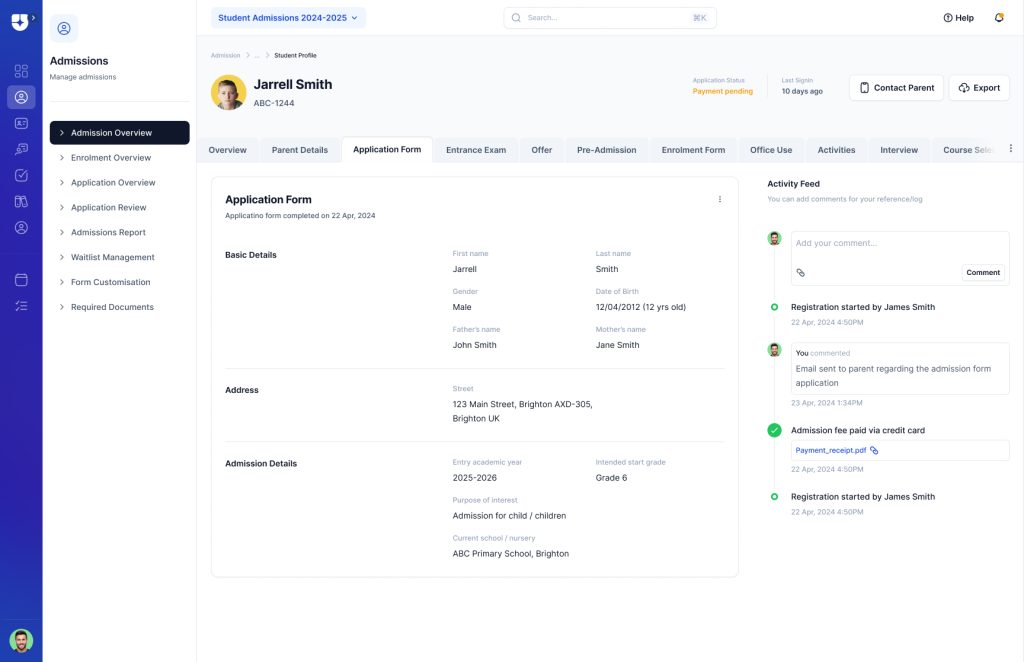Introduction

Create a digital ecosystem for schools to thrive in today’s rapidly evolving educational landscape, where digital transformation in education is no longer optional—it is essential. Schools must adapt to the increasing demands for efficiency, collaboration, and innovation. One of the most effective ways to achieve this is by creating a cohesive digital ecosystem across all departments. Such an ecosystem fosters seamless communication, enhances operational efficiency, and ensures that every aspect of the institution works harmoniously towards common goals. This blog explores how school leaders can build and maintain a unified digital environment that benefits students, staff, and administrators alike.
What Is a Digital Ecosystem?
A digital ecosystem refers to a network of interconnected technologies and systems that work together to streamline processes and improve outcomes. Within a school setting, this ecosystem encompasses tools for administration, teaching,blended learning, communication, and data management. When these elements are integrated effectively, they create a unified framework that supports collaboration and innovation across all departments.For more detailed insights on how digital ecosystems are structured in educational contexts, see this research overview.
The Importance of Cohesion in Digital Ecosystems

The importance of technology in education lies not just in access to digital tools, but in how effectively these tools are connected and used across departments. A well-integrated ecosystem supports teaching technology by streamlining communication, automating workflows, and enhancing collaboration. The true role of technology in education is realised when systems work in unison—creating a unified foundation that empowers educators, administrators, and learners alike.An excellent overview of these concepts can be found in this study on technology integration.
1. Enhanced Collaboration
A cohesive digital ecosystem breaks down silos between departments. Teachers, administrators, IT staff, and other stakeholders can share information effortlessly, enabling better decision-making and fostering a culture of collaboration.
2. Improved Efficiency
A cohesive digital ecosystem breaks down silos between departments. Teachers, administrators, IT staff, and other stakeholders can share information effortlessly, enabling better decision-making and fostering a culture of collaboration.
3. Data-Driven Decision Making
Unified ecosystems enable schools to collect and analyse data from various sources in real time. This data can be used to identify trends, optimise resource allocation, and improve student outcomes.
4. Better User Experience
For students and parents, a cohesive digital educational environment means fewer logins and simplified access to resources. For staff, it ensures intuitive workflows that save time and reduce frustration.
Key Components of a Digital Ecosystem

To drive digital education transformation, it is essential to build an effective digital ecosystem in schools by integrating the following components:
1. Learning Management Systems (LMSs)
LMSs serve as the backbone of modern education by providing platforms for delivering lessons, assignments, quizzes, and feedback. Advanced LMSs now include AI-driven personalisation features that adapt content to individual student needs.
2. Communication Tools
Platforms like email systems, instant messaging apps, and video conferencing tools ensure seamless interaction between staff members, students, and parents. Multi-platform content distribution is increasingly important for engaging diverse audiences effectively.
3. Administrative Systems
From enrolment processes to payroll management, administrative systems streamline operations across departments. AI-powered tools are particularly useful for automating repetitive tasks like grading or generating reports.
4. Data Analytics Platforms
Data analytics tools provide insights into student performance, attendance patterns, teacher effectiveness, and more. These insights enable schools to make informed decisions that drive improvement.
5. Cybersecurity Measures
As schools become more reliant on digitalization and educational tools, robust cybersecurity protocols are essential to protect sensitive information from breaches.
How to Create a Digital Ecosystem for Schools

1. Conduct a Needs Assessment
Begin by evaluating the current state of your school’s digital infrastructure. Identify gaps in technology usage across departments and determine the specific needs of each stakeholder group.
2. Choose Scalable Solutions
Invest in technologies that can grow with your institution’s needs over time. Scalable solutions ensure long-term sustainability without requiring frequent replacements.
3. Prioritise Integration
Select platforms that are compatible with one another or offer APIs for easy integration. Unified systems reduce redundancy and improve workflow efficiency.
4. Train Staff Members
Provide comprehensive training programmes for teachers and administrators to ensure they can use new technologies effectively. Training should cover technical skills as well as strategies for integrating tools into daily workflows.
5. Foster Collaboration
Encourage cross-departmental collaboration during the planning and implementation phases of your digital ecosystem project. Involving all stakeholders ensures that the system meets diverse needs.
6. Monitor Performance
Regularly evaluate the effectiveness of your digital ecosystem using key performance indicators (KPIs) such as user satisfaction rates or improvements in operational efficiency.
Challenges in Building Digital Ecosystems
While the benefits are clear, creating a cohesive digital environment comes with challenges:
- • Resistance to Change: Staff members accustomed to traditional methods may be hesitant to adopt new technologies.
- • Budget Constraints: Implementing advanced systems requires significant investment.
- • Cybersecurity Risks: Increased reliance on digital tools in education makes schools vulnerable to cyberattacks.
- • Complexity of Integration: Ensuring compatibility between various platforms can be technically challenging.
However, these challenges can be mitigated through strategic planning and stakeholder engagement.
Case Study: Battle Abbey School’s Digital Transformation
Battle Abbey School in Europe provides an excellent example of successful digital integration. By implementing iPads across its curriculum—from nursery to senior school—the institution achieved seamless collaboration within faculties while enhancing learning outcomes through interactive technologies like virtual labs in science lessons. Their grassroots approach involved training staff members extensively while fostering leadership within departments—a strategy that other schools can emulate.
Future Outlook
As we approach 2025, the importance of cohesive digital ecosystems will only grow. Emerging technologies such as AI-driven assistants, VR/AR experiences, and advanced LMS innovations will continue to redefine education delivery methods while demanding greater integration across departments.
Schools that invest in creating unified ecosystems will be better positioned to adapt to these changes while improving student engagement and operational efficiency.
Conclusion
Creating a cohesive digital ecosystem across all school departments is not just about adopting new technologies; it is about fostering collaboration, enhancing efficiency, and preparing students for a rapidly digitising world. By prioritising integration, scalability, training, and security measures, school leaders can build environments where digital technology in education empowers rather than overwhelms.
With thoughtful planning and execution, schools can transform their operations into interconnected hubs of innovation—ensuring success not only for their institutions but also for their students’ futures in an increasingly complex world of work and learning.
“True innovation in education begins when every department connects, collaborates, and thrives through one unified digital ecosystem.”
FAQs
1. What is a digital ecosystem in education?
A digital ecosystem in education refers to a network of interconnected technologies and systems that work together to streamline processes and improve outcomes in schools. It integrates tools for teaching, administration, communication, and data management to create a unified framework.
2. Why is a cohesive digital ecosystem important for schools?
A cohesive digital ecosystem enhances collaboration between departments, improves operational efficiency, and enables data-driven decision-making. It ensures that all stakeholders—teachers, administrators, students, and parents—can work seamlessly within the same technological environment.
3. What are the key components of a digital ecosystem in schools?
Key components include:
• Learning Management Systems (LMSs) for teaching and learning.
• Communication tools such as email platforms and video conferencing applications.
• Administrative systems for tasks like enrolment and payroll.
• Data analytics platforms for monitoring performance and outcomes.
• Cybersecurity measures to protect sensitive information.
4. How can schools ensure successful implementation of a digital ecosystem?
Schools can ensure successful implementation by:
• Conducting a thorough needs assessment to identify gaps in their current infrastructure.
• Choosing scalable solutions that grow with the institution.
• Prioritising integration between platforms to reduce redundancy.
• Providing extensive training programmes for staff.
• Encouraging collaboration across departments during planning and execution phases.
5. What challenges do schools face when building a digital ecosystem?
Common challenges include:
• Resistance to change among staff members accustomed to traditional methods.
• Budget constraints limiting access to advanced technologies.
• Cybersecurity risks associated with increased reliance on digital tools.
• The technical complexity of integrating multiple systems into one cohesive framework.

